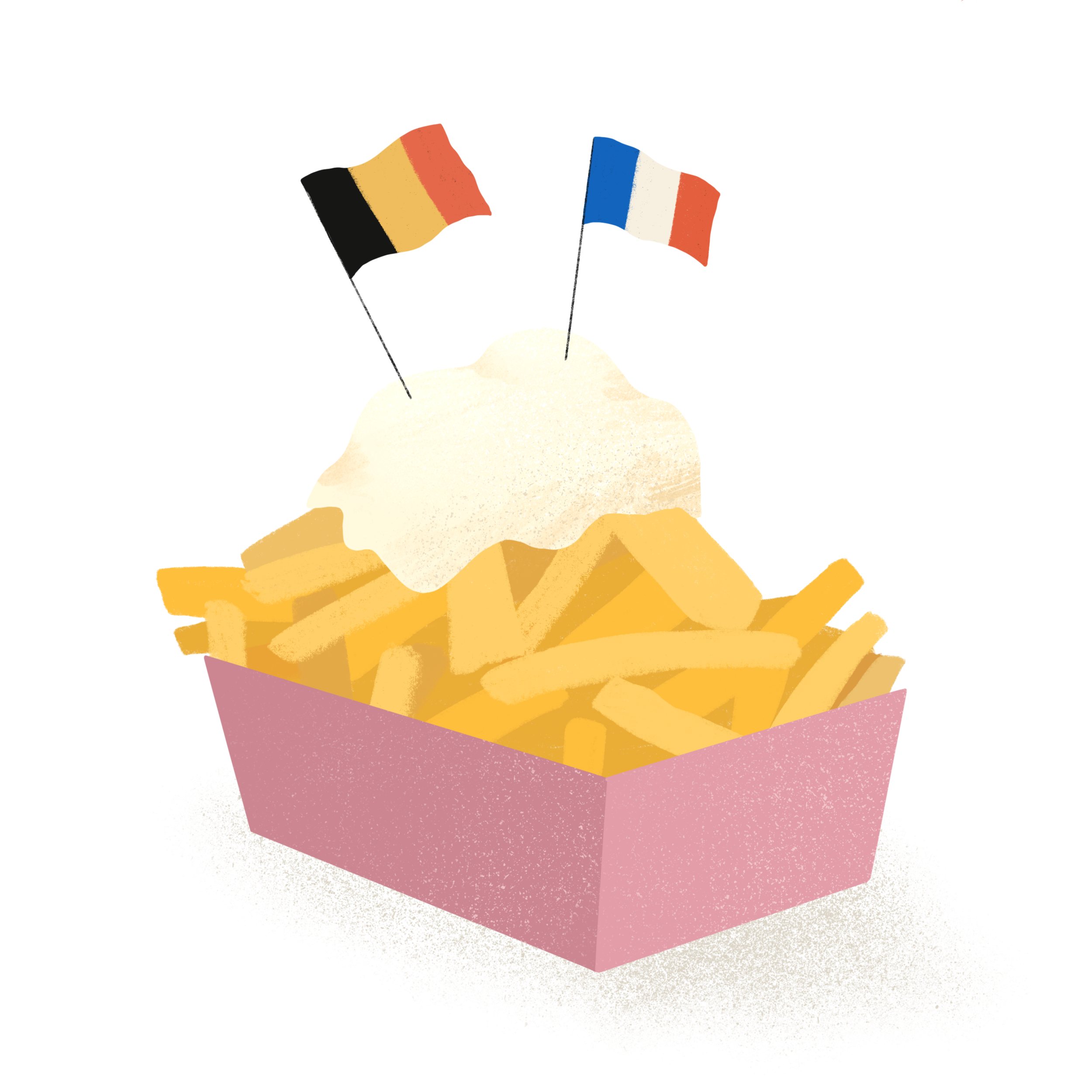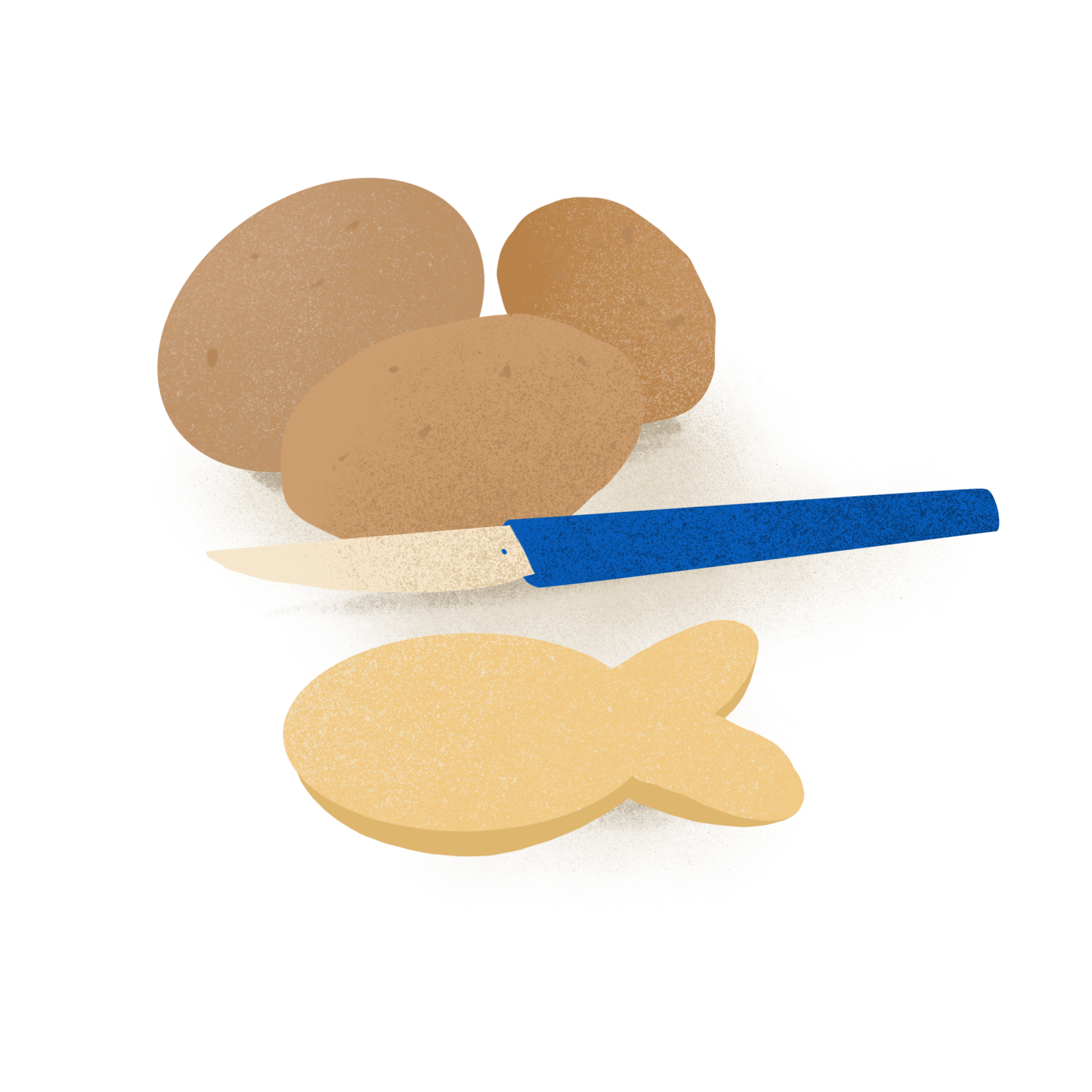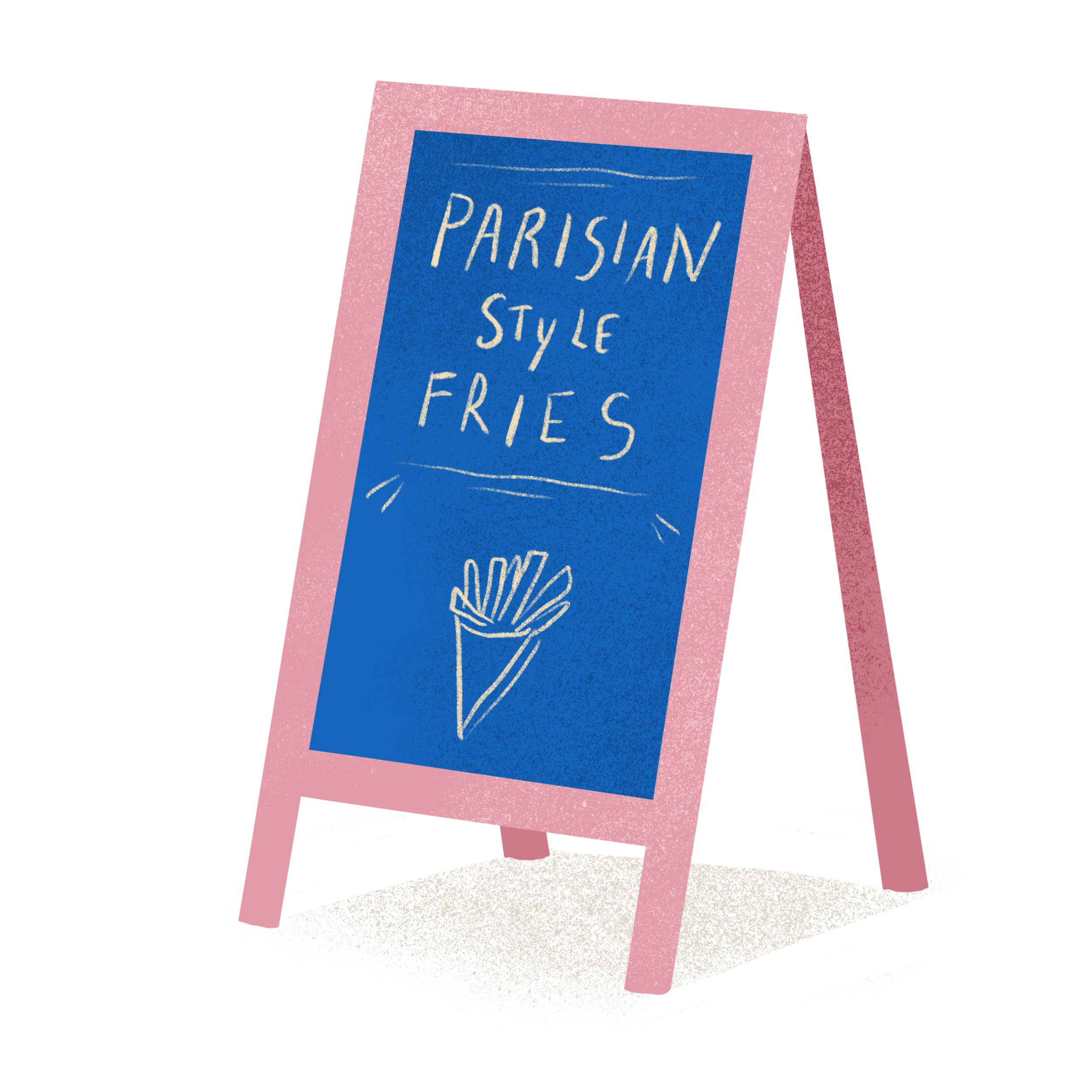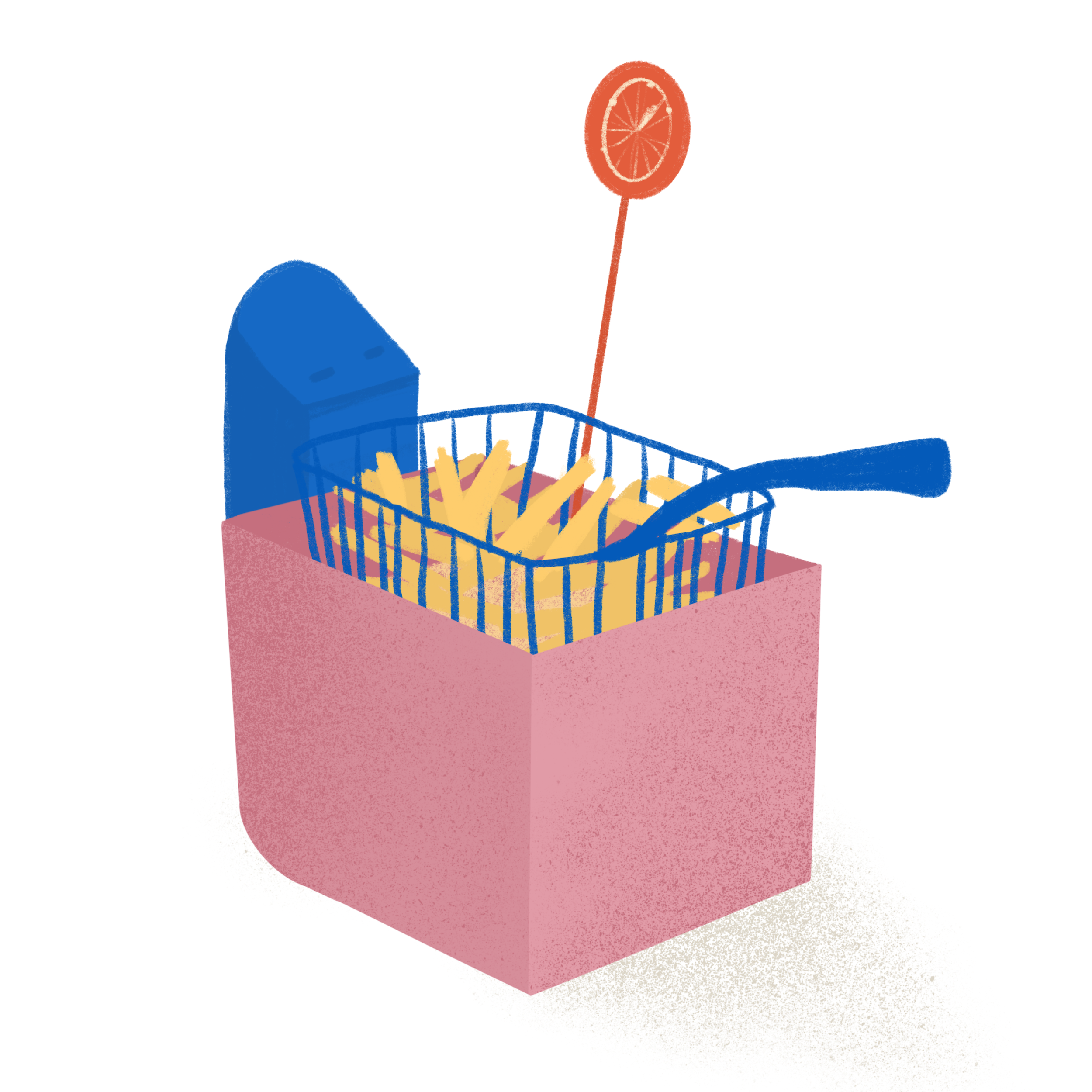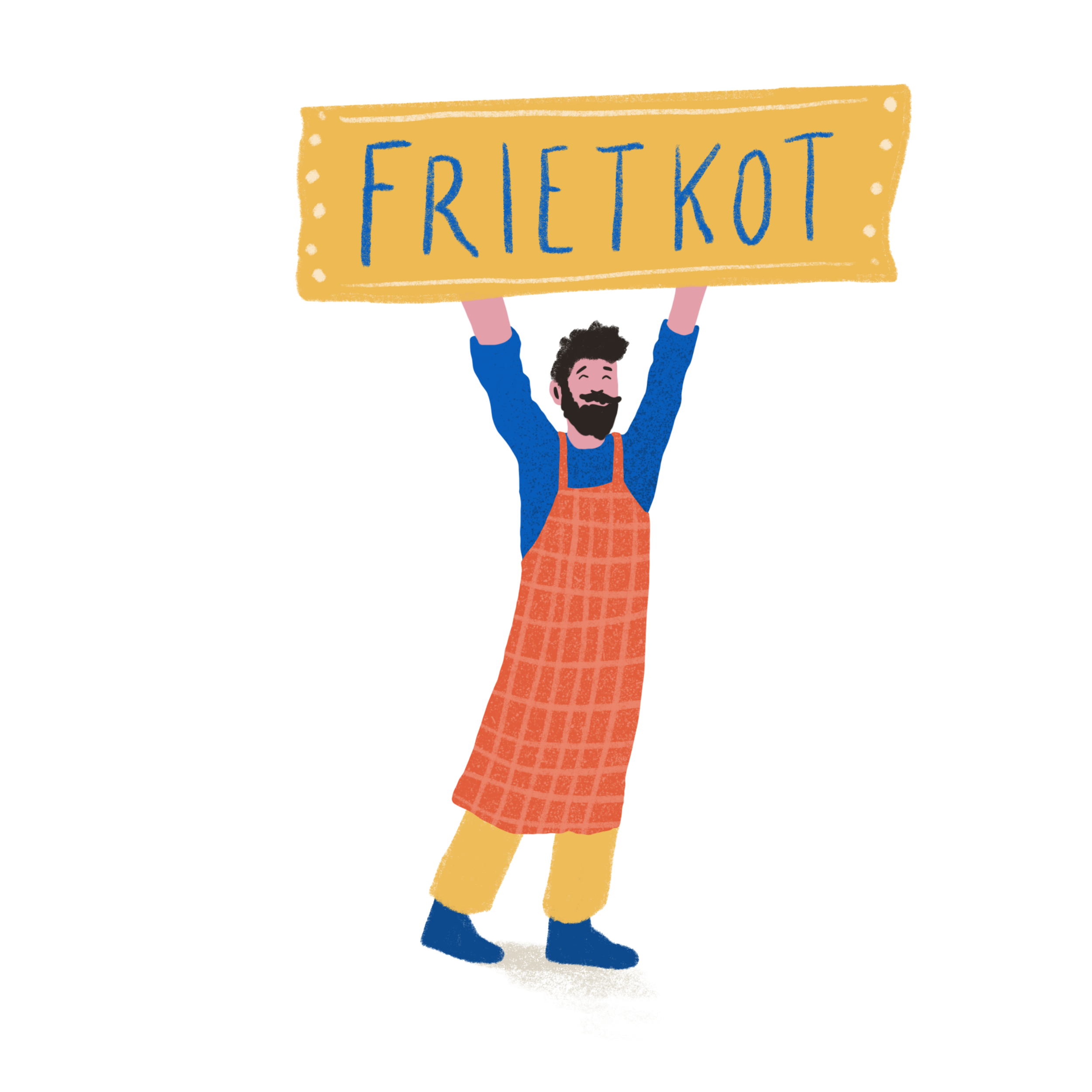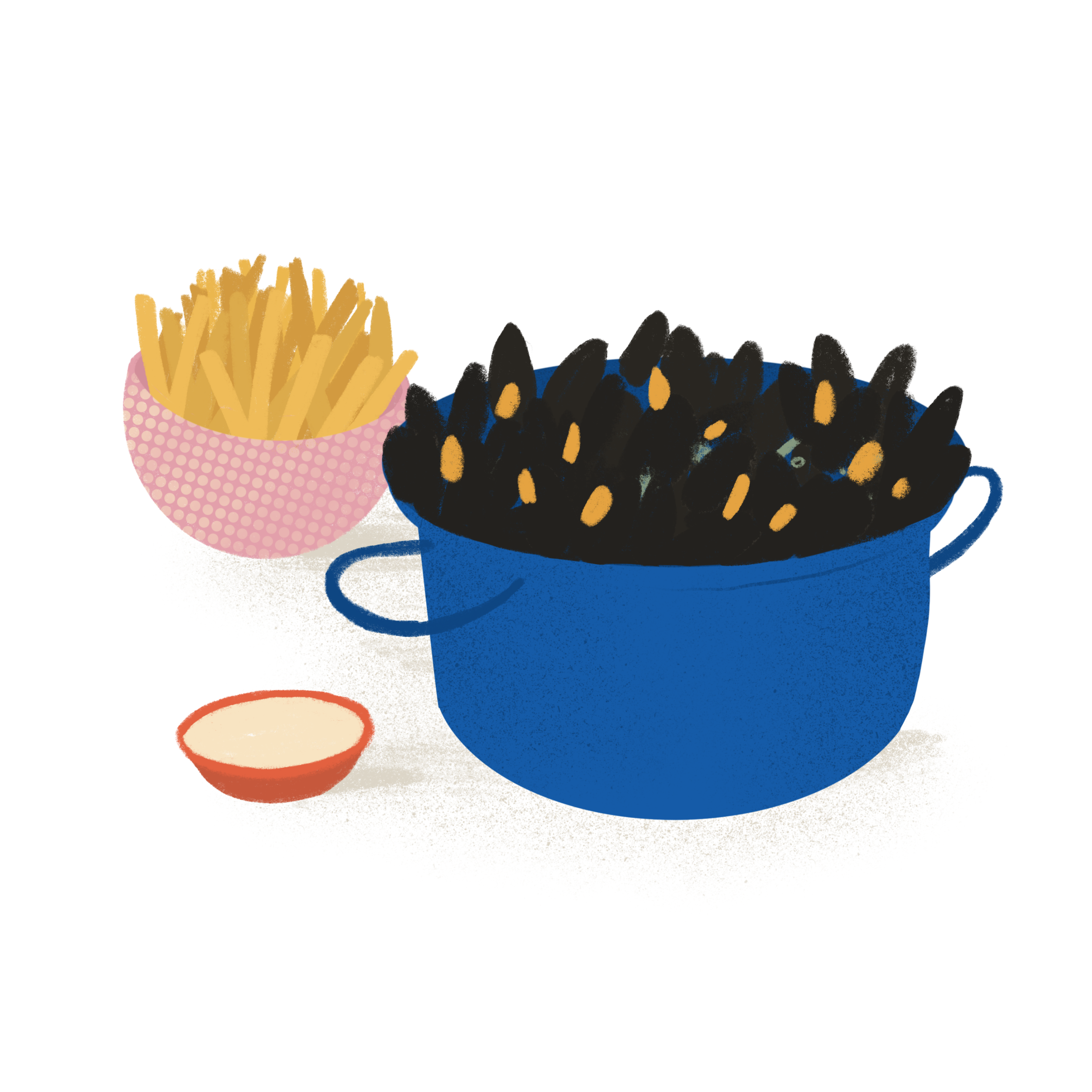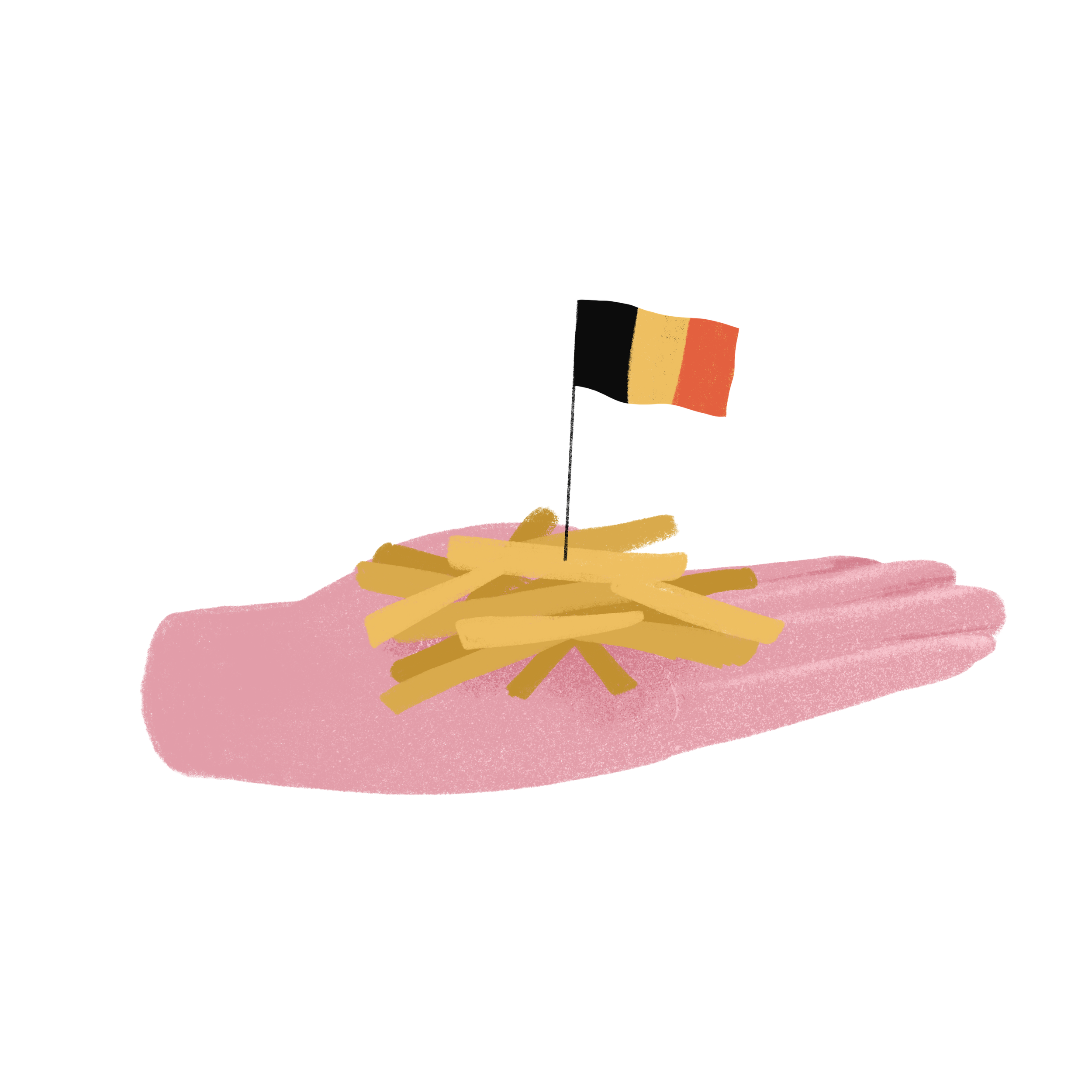How does Belgium’s relationship with fries differ to other countries and why do they claim cultural ownership of these elongated pieces of deep fried potatoes?
Words by Breandán Kearney
Illustrations by Flore Deman
Edited by Oisín Kearney & Ciara Elizabeth Smyth
This editorially independent story has been supported by VISITFLANDERS as part of the “Food Group” series. Read more.
I.
“Please, stop lying.”
In 2015 at the South by Southwest (SXSW) Music and Film Festival in Austin, Texas, the Belgian musician Paul van Haver, better known as Stromae, performed his song Moules Frites (Mussels and Fries) to an enthusiastic audience. He introduced the song by correcting the Americans on their use of the term french fries.
“You know I come from Belgium so I know the truth about this,” Stromae told the crowd. “So please, French people—Don’t be so proud. Please, tell to the US citizens that the french fries is not french fries, but belgian fries. Please, stop lying. Merci beaucoup.”
Fries, known as chips in Britain and Ireland and french fries in the United States and Canada, are thinly-sliced, deep-fried potatoes, often served as an accompaniment to other foods, but sometimes as a main course.
The exact origin of fries is disputed by historians, journalists, and cultural commentators. Nobody can be certain where potatoes were first peeled, chipped and cooked in oil to create fries or who might have first done it. What does seem clear from historical documents is that fries—at least those in a form resembling what we eat today—were first popularised in Paris at the turn of the 19th century.
However, when these “Parisian-style fried potatoes” made their way to Belgium in the 1840s, three things happened:
The first was the adoption by the Belgians of the “double-fry method”.
The second was the proliferation of the frietkot as a cultural phenomenon throughout the country: small independent businesses who sold fries in gathering spaces from temporary structures such as converted vans and quirky kiosks.
And the third was the choice of foods with which the Belgians uniquely paired their fries: most notably mussels, and later mayonnaise.
The foremost fries historian in Belgium, Pierre Leclerq, believes that fries as we know them today are “the result of a slow and long evolution, both technical and cultural.” He says that over the last 250 years, they’ve gone from a pan-fried circle to little sticks dipped twice in a bath of fat. They’re an essential cultural product, he says, easily identifiable, perfect for sharing, and evoking personal memories for those who eat them. For him, the Belgians have “forged an original fries culture that has emancipated itself from Parisian culture.”
In terms of how deeply a part of their food culture fries have become, Belgians have developed a relationship with fries which no other country in the world can match today. They may not have invented fries, but can they claim to own them?
II.
The Facts
Despite the lack of evidence, there are still suggestions that fries originated in Belgium.
One of the most bizarre myths is that fries were “invented” in the 17th century at Belgium’s River Meuse, where inhabitants of towns near the Walloon city of Namur were known to catch small fish and then fry them. When the river froze over, the locals would instead cut potatoes into the shape of the small fish and then fry them.
So claimed Belgian journalist Jo Gérard when he came across historical documents from his grandfather’s records in the 1970s. Gérard took these records to be the first reference to fries in history.
However, the myth has since been debunked: potatoes were still unknown in Namur in 1680 when Gérard claims the Belgians used them to “invent” fries and only came to the region in 1735.
Another myth is that American soldiers stationed in Belgium during the First World War were served fries in Belgium and named them french fries because, hearing the French language, they believed that they were actually in France.
But the term french fries already existed in the USA long before WWI. And in any case, it’s highly unlikely that soldiers wouldn’t have known they were in Belgium.
“In the U.S., Belgium had this image of being a violated country by the Germans,” says Peter Scholliers, food historian and Professor of Contemporary History at Vrije Universiteit Brussel. “Actually, world solidarity and Oxfam and things like that started in the U.S. with the help of Belgium. So Belgium was known.”
Another myth is that the french in french fries relates not to France, but to the culinary process of frenching, a method of cutting meat and vegetables into thin strips to make them more attractive.
But historian Pierre Leclerq says it’s the exact opposite. “It is the adjective french, from the expression french fries, which inspired the verb to french or ‘to cut into sticks’. Not the other way around.”
A more accurate historical summary might be as follows: In the late 1700s, donut vendors on Pont-Neuf in Paris started serving potatoes that had been cooked in a bath of fat. Soon after, fried potatoes turned up in bourgeois culinary culture in Paris, gentrifying in wealthy households and restaurants.
At the same time, the people living in what is now called Belgium were already big fans of the potato, eating eight times as many potatoes as those living in what is modern day France (200 kgs v 25 kgs according to a survey carried out across the French Empire in 1813). The Belgians were impoverished and the potato was easy and cheap to grow with a high calorific offering.
The Belgians were so enamoured with the potato that if only someone could bring the thinly-cut, deep-fried version of the potato to Belgium, then it might just catch on.

III.
Monsieur Fritz
Jean Frédéric Krieger was a Bavarian musician who travelled around playing music at the fairgrounds that were growing in popularity across Europe in the first half of the 19th century.
While in Paris, he was hired as a clerk at the rotisserie Chez Pèlerin and learned how to make “Parisian-style fried potatoes”.
In the 1840s, the fried potato was everywhere on the streets of Paris, eulogised in popular novels, newspapers, and songs across France.
Krieger married a musician from Brussels and, according to historian Pierre Leclerq, founded the first known frietkot in Belgium in 1844.
He quickly became known as “Monsieur Fritz”.
From 1845 onwards, Krieger began travelling across Flanders and Wallonia, selling his fries to a captivated public.
It was such a success that other establishments began popping up selling Monsieur Fritz’s “Parisian-style fried potatoes”.
Developments in farming meant potatoes were getting cheaper. Peter Schollier’s menus from fries vendors at that time indicate that between 1840 and 1870, a sachet of fries went from costing half of the average hourly wage to a fifth of the average hourly wage.
The gradual increase in the amount of frietkots meant they were becoming more convenient to buy. You could eat them with your fingers from a cone or old newspaper. And they filled you up.
Then something happened that set Belgian fries apart from their Parisian forebears.
IV.
Double Fry
You have to fry them twice, according to Hugues Henry.
Henry is a fries enthusiast, cultural journalist, and passionate collector. He runs “micro-museum” Home Frit Home. In the museum, he celebrates fries literature by writer and historian Paul Ilegems, fries films by anarchist and artist Jan Bucquoy, and fries songs, such as Grand Jojo’s “Chef, un p’tit frites on a faim” (“Barman, a little fries, we’re hungry”). It’s not the only museum dedicated to fries in Belgium; there’s a more commercial visitor experience on the Vlamingstraat in Bruges called the Belgian Fries Museum.
For Hugues Henry, the starting point for fries is a good quality potato (he recommends the Binche cultivar). “Then you need to cut it into sticks,” he says. “Ten millimetres on each side. If you don’t do that, you will not have enough purée to have the soft inside. Any bigger, and you won’t have the pleasure of eating all of these sticks together.”
Henry describes the Double Fry method. Beef tallow or ox fat are traditionally used and by far the most common, although some use vegetable fat to ensure vegans can enjoy fries too. “The first time, it’s at a lower temperature. You create this purée. Then you put them on the side to rest. Then you raise the temperature. The second frying will be to really fry them to have this crispy texture and gold colour.”
According to Pierre Leclerq, the Belgians “distinguished themselves by the generalisation of double frying”, the formula for which was mentioned for the first time in a Belgian educational book entitled L’école ménagère, published in 1892 to accompany a course at the homemaking school of Verviers (written by Louisa Mathieu and published by Vinche Printing).
It’s not certain whether double-frying became ubiquitous in the country because of this book, or whether this book was codifying a technique that was already being deployed by everyone in Belgium. What is certain, however, is that all French cook books of the same era recommended a single frying, and it wasn’t until 1936 that double-frying was first recommended in a French cook book, Henri-Paul Pellaprat’s L’art culinaire moderne.
Recommendations for frying temperatures across recipes for belgian fries vary greatly. Temperatures for the first frying can be anywhere between 130°C (266°F) and 160°C (320°F). The second frying is most often carried out at around 175°C (347°F) or above.
“In Belgium, people do not agree,” says Henry. “Everyone is doing it in his or her own way.”
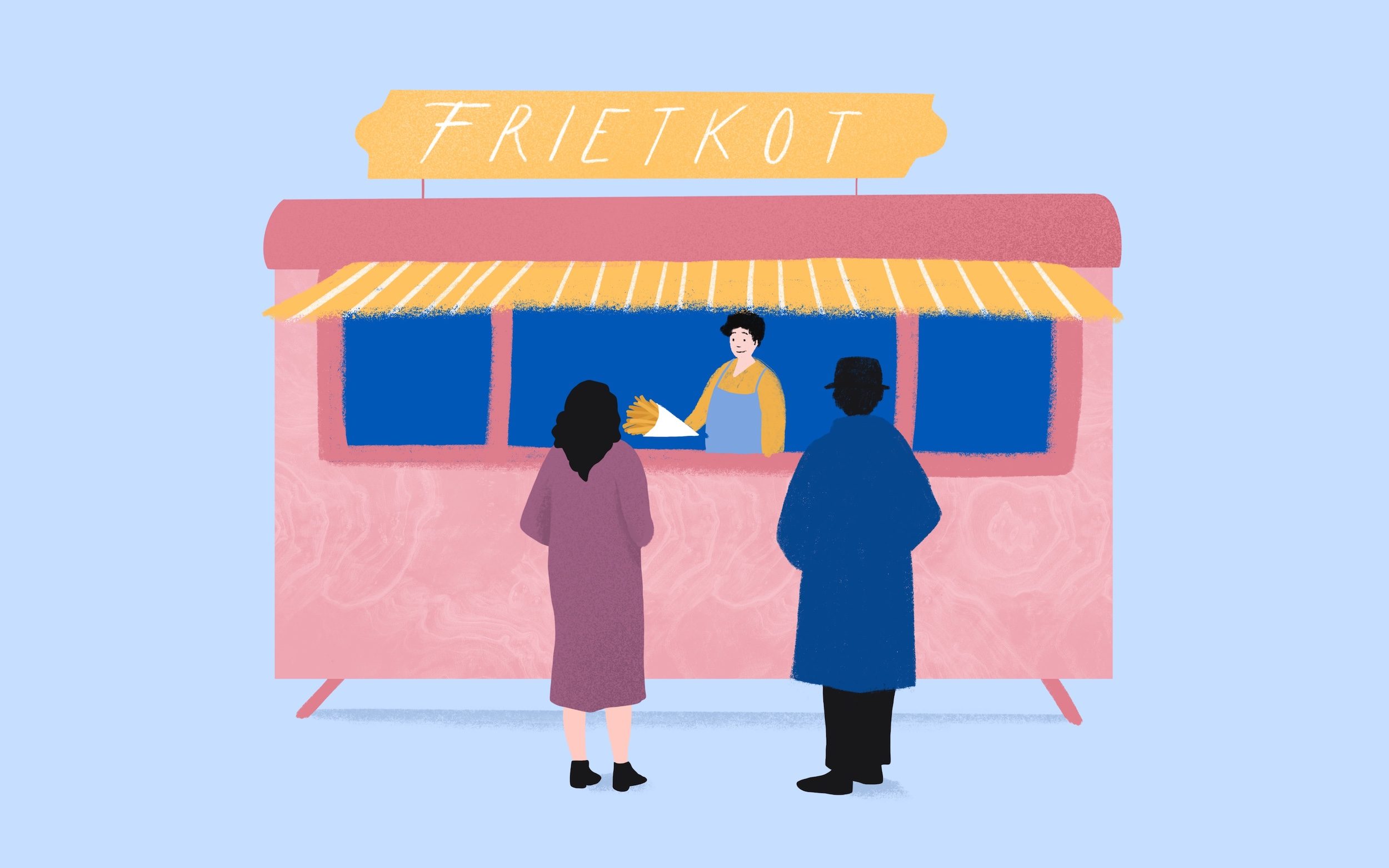
V.
Frietkot
Belgians eat more fries per capita than any other nation. They consume them at home, but also in Frituren (Dutch) or fritures (French), most commonly known as frietkoten or fritkots.
In other countries, shops that sell fries are located in permanent buildings, and are often owned by fast food chains.
In Belgium, frietkoten are predominantly small independent businesses in temporary structures which pop up on main highways as much as in town squares. While fries are also served in Belgian restaurants with table service, frietkoten are small kiosks with big reputations or converted vans parked up near a café. Because of this prevalence and independence, the frietkot experience in Belgium is highly varied.
“We have 4640 different ways of Belgian fries,” says Bernard Lefevre, President of the National Union of Fristuristen in Belgium, UNAFRI-NAVEFRI. “They all taste different. I don’t say I like them all. But I know that some people like them, otherwise they wouldn’t stay open.”
Lefevre acknowledges that fries are unlikely to have originated in Belgium—”We didn’t invent it,” he says—but he stresses the uniqueness of Belgium’s frietkot culture. “I don’t mind people calling them french fries, because I wouldn’t like all fries I’ve eaten in the world to be called Belgian,” says Lefevre. “I think the people in the Champagne [region] wouldn’t like every sparkling wine to be called Champagne.” What is for sure is that there is no other country where fries are part of the everyday life of all people in the country. Lefevre stresses this point: “If you put a flag on every frietkot, you have the map of Belgium.”
The story of the frietkot itself is tied to the rise of village fairs in Belgium at the beginning of the twentieth century. “It takes much more time to build a carousel or to build a tent for a circus,” explains Lefevre. ”With a food truck, you just come, you heat the oil and you sell. So they could just start selling as one of the first shops, and they could stay there till the very last when the others already went. And some said, well, maybe we don’t have to drive. We just can stay here under the church. And then they broke away the wheels and they didn’t move anymore.”
There are in the region of 4,500 frietkoten in Belgium, essentially a fries kiosk for every 2,500 people in the country—the highest number of frietkoten per capita in Europe. All Belgians have a “stamfrituur” (a local fries shop). 85% of Flemings eat fries at least once a month (half of all Belgians), and over 60% of Flemings do so at least once a week (a quarter of all Belgians).
It’s a phenomenon which has thrived despite its fair share of challenges.
During the 1980s, a large number of frietkots closed down and others started to settle into more permanent premises as town mayors in Belgium tried to make their urban spaces less unsightly and cluttered.
The frietkot can sometimes be an ugly, disfiguring element of a village, a make-shift structure improvised against a beautiful church, blemishing the medieval aesthetic, or plopped down as an eye-sore in an historic town square.
But in a way, it’s also a charming symbol of the spatial disorder of Belgian urban planning, a nod to the chaotic but fascinating nature of the country’s towns and villages.
Another challenge, according to Lefevre, has been “the Americanisation of our culture, generally speaking, and our food culture, in particular.” But the love affair between Belgians and their frietkot has managed to fend off fast food chains that have more deeply infiltrated other nations: Belgium, for example, has one of the lowest proportions of McDonald’s restaurants per inhabitant in the developed world.
Lefevre points to desirable trends in food production today and believes that frietkoten have actually come to stand for values which would today be considered “top marketing”: “Local products, a short way between the producer and the seller, and social contact,” he says. “It’s an honest product.”
VI.
Moules Frites
The tradition of mussels and fries in Belgium dates back to the 1860s, a food combination that had previously been ignored by other nations, including the French who preferred fries as an accompaniment to steak.
In the 1870s, restaurants specialising in mussels and fries began opening up in Belgium. Mussels were a cheap foodstuff popular on the Flemish coast and once they began playing with variations, Belgians developed a taste for it that could not be satiated.
Most popular are mussels with a sauce of white wine or wheat beer, together with shallots, parsley, and butter, but there are also recipes that involve celery, leeks, cream, garlic, and a lemon-mustard-sauce. Today, mussels and fries are an icon of Belgian cuisine, some considering it the national dish. It even inspired the seventh track (Moules Frites) on Stromae’s second album Racine carrée, released on 16 August 2013 to critical-acclaim, selling over 2.5 million copies.
Similarly, fries with mayonnaise has become emblematic of food culture in Belgium. Due to historical decrees signed by the King of Belgium, mayonnaise has traditionally been richer, more full-textured, and more intensely flavoured than in other countries. Mayonnaise’s subtle acidity cuts the fat of Belgian fries and the sauce’s sweet creaminess complements their crispiness.
There are other sauces too that are paired with fries.
Tartar sauce is made from adding onions, capers, and other herbs to mayonnaise. Andalouse sauce is essentially mayonnaise mixed with tomato paste and crushed, roasted red bell peppers. Cocktail sauce is a combination of mayonnaise, ketchup, and whiskey. Diablo sauce is mayonnaise mixed with red-pepper puree. Samourai sauce is mayonnaise mixed with ketchup and harissa hot chilli paste. Americain sauce is andalouse sauce flavoured with carrots, celery, and onion. Joppie sauce is mayonnaise with mild curry spices.
All of these sauces are based on mayonnaise, even if you’d never believe it from tasting them.
They share one existential goal: to bring fries in Belgium to the next level.
VII.
Ownership
The underlying tension in the claim for fries hinges on the definition of cultural ownership itself.
Who can claim ownership over food?
Do those who first created a food own it?
Or does it belong to those that perfected it?
Here’s an answer by way of a question:
Where’s the one place in the world you would go to enjoy the most unique fries experience you could imagine?
Or put another way:
If I offered to bring you to a characterful frietkot in a quirky medieval square in Belgium and serve you 10mm-long fries hand-cut from high quality Belgian-grown potatoes, double-fried in ox fat at two different temperatures, and served to you in a paper cone with a dollop of rich, creamy Belgian mayonnaise on the side, would you refuse?
*



